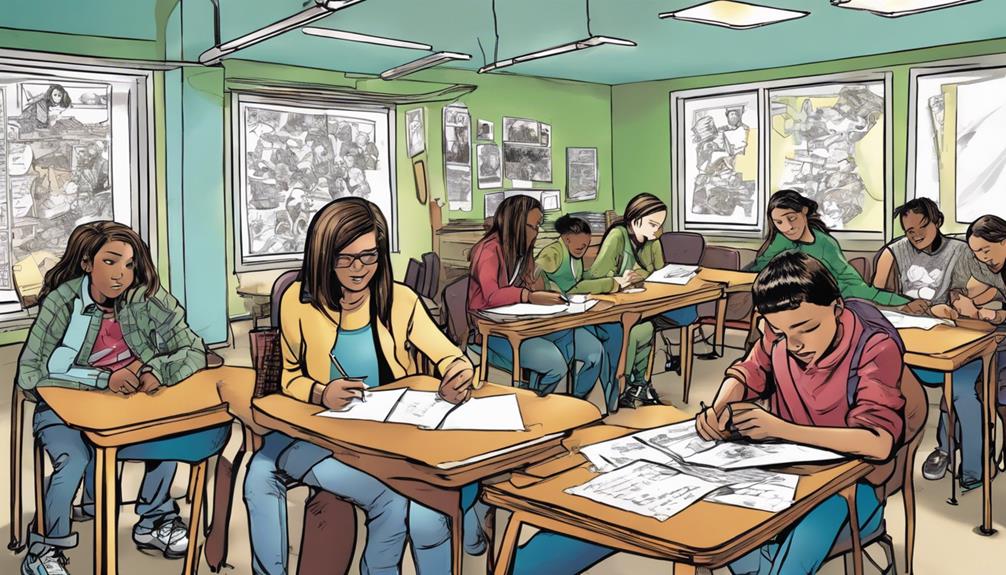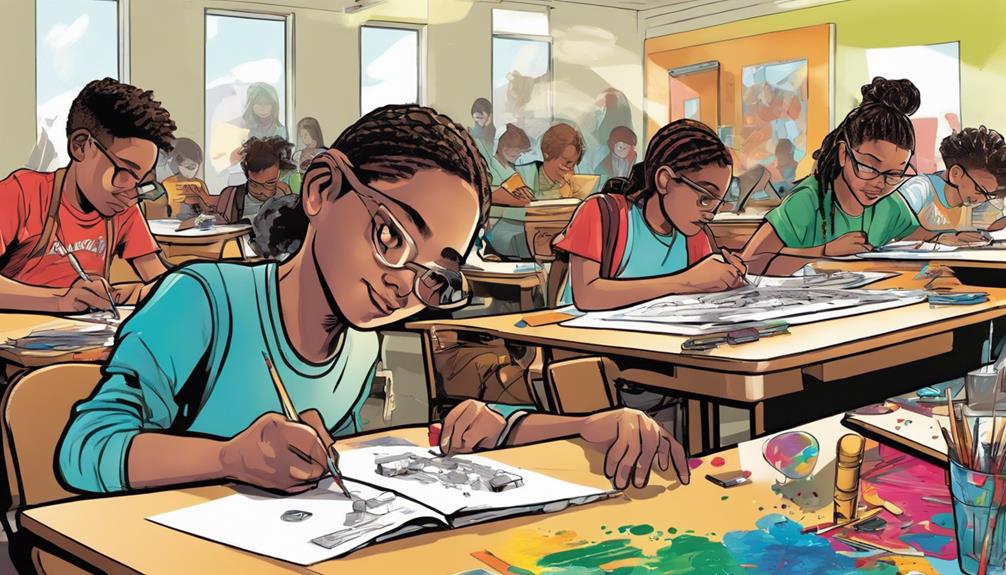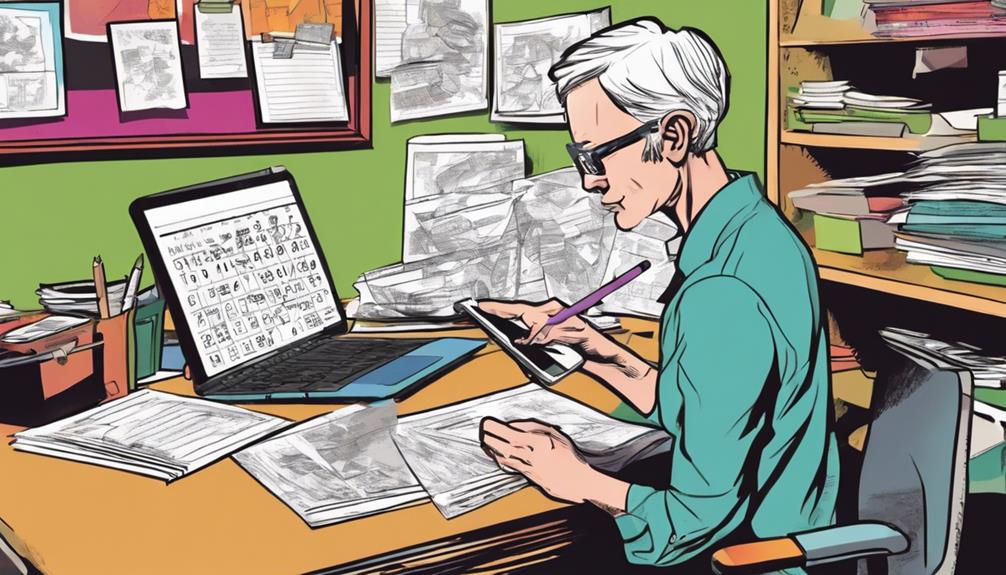Ready to ignite creativity in your students? Here’s how! Start by facilitating brainstorming sessions to spark a torrent of ideas. Then, incorporate art and music to inspire unique forms of expression. After that, consider using open-ended assignments to nurture creativity. Encourage taking risks to challenge boundaries and provide opportunities for self-expression. Get involved in hands-on activities for hands-on learning. Try think-pair-share and Quiz, Quiz and Trade methods for interactive enjoyment. Shake things up by introducing brain teasers and a variety of activities to break the monotony. Foster creativity through active engagement by exploring innovative solutions and welcoming diverse ideas. Keep the flame alive!
Key Takeaways
- Implement project-based learning to encourage hands-on creativity.
- Introduce design thinking exercises for problem-solving skills.
- Use technology for interactive learning experiences.
- Foster a culture of curiosity and exploration in the classroom.
- Incorporate real-world challenges to inspire innovative solutions.
Importance of Creativity in Education

Spark your students' creativity by emphasizing its essential role in education. Creativity isn't just about art; it's about thinking differently, solving problems uniquely, and preparing for the challenges of tomorrow.
When students are encouraged to be creative, they develop important skills like critical thinking and innovation. Imagine a classroom where students tackle complex issues with fresh ideas, where they express themselves freely, and where they learn to adapt and thrive in a rapidly changing world.
Strategies to Foster Creativity

To cultivate creativity effectively in students, it's crucial to implement various strategies that encourage innovative thinking and problem-solving skills. One way to do this is by promoting brainstorming sessions where students can freely share their ideas without fear of judgment.
Incorporating art and music into lessons can also inspire creativity and help students express themselves differently. Providing open-ended assignments allows room for creativity to flourish, while supporting risk-taking and experimentation helps students step out of their comfort zones.
Offering opportunities for self-expression through projects or presentations can further nurture creativity. By embracing these strategies, you can create a dynamic and engaging learning environment that sparks creativity in your students.
Active Learning Techniques

Engage your students actively in the learning process by utilizing various techniques that promote hands-on participation and collaboration.
Think-pair-share activities are a fantastic way to encourage student interaction and critical thinking.
Implement the Quiz, Quiz and Trade method for a fun and engaging way to review material.
Hands-on projects allow students to apply theoretical knowledge in practical scenarios, enhancing their understanding and retention.
Group discussions foster communication skills and provide different perspectives on topics.
Real-world problem-solving tasks challenge students to think creatively and apply their skills in authentic situations.
Breaking Monotony in Learning

To maintain a dynamic and engaging classroom environment, introduce breaks in routines when breaking monotony in learning. Think of it like adding a little spice to your favorite dish – it keeps things interesting!
By avoiding repetitive teaching methods and trying different approaches to instruction, you can stimulate your brain with varied activities. For example, mix up your usual lecture with a group discussion or a hands-on project. Maybe throw in a quick brain teaser or a fun educational game to shake things up.
Fostering Creativity Through Engagement

By engaging students in creative activities like storytelling and poetry, you can effectively foster their creativity and imagination. Encouraging them to think outside the box and explore innovative solutions not only boosts their problem-solving skills but also nurtures a mindset of originality. Welcoming diverse ideas and providing constructive feedback further enhances their creative capabilities. To spark inspiration, consider integrating engaging tasks such as creating a collaborative story or composing a group poem. These activities not only stimulate their imagination but also promote teamwork and idea sharing. Cultivating creativity from a young age through such engaging tasks is key to developing well-rounded individuals ready to tackle future challenges.
| Benefits of Engaging Creativity Through Activities |
|---|
| Enhances problem-solving skills |
| Fosters innovation and originality |
| Boosts imagination and critical thinking |
| Encourages teamwork and idea sharing |
Frequently Asked Questions
How Can Creativity in Education Benefit Students' Social Skills?
Creativity in education enhances social skills by fostering collaboration, empathy, and effective communication. Through innovative approaches and diverse activities, students can develop strong relationships, understand perspectives, and engage constructively in group settings.
What Role Does Playtime Have in Fostering Creativity in Students?
Playtime plays an essential role in fostering creativity in students. It allows for exploration, imagination, and experimentation, helping develop problem-solving skills and innovative thinking. Encouraging play enhances creativity, making learning more engaging and effective.
How Can Teachers Support Introverted Students in Expressing Creativity?
To support introverted students in expressing creativity, remember they're like gentle flowers blooming in their own time. Encourage private reflection, offer alternative ways to share ideas, provide a safe space for expression, and celebrate their unique contributions.
Are There Specific Strategies to Help Students Overcome Creative Blocks?
When facing creative blocks, remember to take breaks and explore new perspectives. Embrace brainstorming and open-ended tasks. Encourage risk-taking and experimentation. Your creativity thrives when you seek inspiration from various sources and trust your innovative ideas.
Can Creativity Be Measured and Assessed in a Standardized Way?
Creativity, though subjective, can be assessed through diverse methods like project portfolios, rubrics, and peer evaluations. While not easily standardized, these approaches capture the essence of creative thinking and problem-solving skills effectively.
Conclusion
To sum up, creativity is an essential skill that can revolutionize the way students learn and grow.
Did you know that 94% of employers believe creativity is a crucial factor for future success in the workplace?
By implementing innovative strategies like active learning techniques and engaging activities, you can ignite a spark of creativity in your students and prepare them for the challenges of tomorrow.
So, let's unlock their creative potential and watch them soar!










